Vegetarian Sushi Rolls
4.6
(11)
Your folders
Your folders
Prep Time: 45 minutes
Total: 105 minutes
Servings: 6
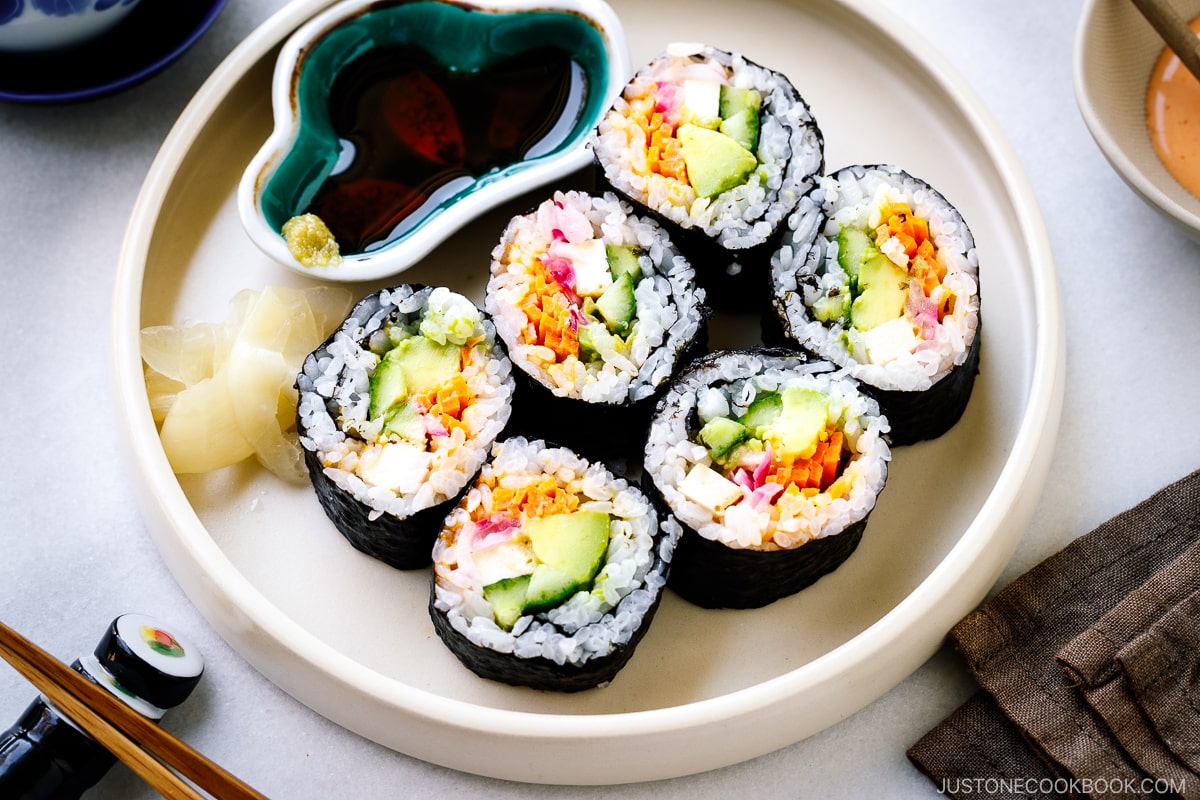
Ingredients
Export 13 ingredients for grocery delivery
Instructions
Step 1
Before You Start: You must use Japanese short-grain rice or your sushi will fall apart. Please note that ¾ measuring cup of uncooked Japanese rice is 1 rice cooker cup (150 g, 5.3 oz) and yields roughly 2¼ cups (330 g, 11.6 oz) of cooked rice. One sushi roll requires 1 US cup (150 g) of sushi rice.
Step 2
Gather all the ingredients.
Step 3
Rinse 2¼ cups uncooked Japanese short-grain white rice until the water is almost clear (you can learn how to properly rinse the rice in my post on How to Make Sushi Rice). Put the well-drained rice in the rice cooker inner pot and add 2¼ cups water to just under the 3-cup line for White Rice. If your rice cooker has a Sushi Rice mode, add water up to that line. Place 1 piece kombu (dried kelp) on top of the rice (optional) and let the rice soak in the water for 20–30 minutes. Then, start cooking. If you don‘t have a rice cooker, cook the rice in a pot over the stove, Instant Pot, or donabe with the amount of water I specified in this recipe. Tip: Since we‘ll be adding sushi vinegar to the steamed rice, cook the rice a little bit on the firm side. To achieve this, use a rice-to-water ratio of 1 to 1 for sushi rice (instead of 1 to 1.1 or 1 to 1.2 for regular steamed rice). While the rice is cooking, prepare the rest of the ingredients.
Step 4
When the rice is cooked, discard the used kombu (or repurpose it to make simmered kombu). If using a wooden sushi oke (also called hangiri), moisten it by running water over it and drain well. You can also use a baking sheet lined with parchment paper. Transfer the cooked rice to the sushi oke and spread out the rice evenly so it will cool faster.
Step 5
While it’s hot, pour ⅓ cup seasoned rice vinegar (sushi vinegar) over the rice. With a rice paddle, gently “slice“ the rice at a 45-degree angle to incorporate the sushi vinegar mixture and separate the chunks of rice. Do not stir or mix the rice because the grains may break and the rice will become mushy. While using this slicing motion, vigorously fan the rice with a paddle fan or another type of fan. This cools the rice and takes away the excess moisture. Fanning makes the rice shine and keeps it from becoming mushy. Then, gently flip the rice in between slices. Repeat this process until the rice is cooled to the temperature of human skin. Keep the sushi rice covered with a damp towel (or paper towel) for a few hours at room temperature. To keep it for a longer time, see the To Store section below.
Step 6
Thinly slice ½ red onion and transfer it to a glass jar (or bowl). Add ½ cup seasoned rice vinegar (sushi vinegar) or until they are just covered. Set aside until you prepare the other ingredients.
Step 7
In a small bowl, combine ¼ cup Japanese Kewpie mayonnaise, 1 Tbsp sriracha sauce, and splash lime juice and mix it all together. Set it aside.
Step 8
Cut 2 Japanese or Persian cucumbers in half lengthwise and remove the seeds with a spoon. Then, slice each half into 4 long strips. Tip: Seeds contain moisture; therefore, we discard them to avoid excess moisture inside the sushi rolls.
Step 9
Using a julienne peeler, peel 1 carrot to make julienned strips. If you have a regular vegetable peeler, peel thinly, then cut the sheets into long, thin julienned strips.
Step 10
Cut 1 deep-fried firm tofu cutlet (atsuage) into slabs. Then, cut the slabs into long sticks.
Step 11
When everything else is ready, cut 2 avocados in half lengthwise around the seed. Twist the two halves until they separate. Now, if you‘re new to removing the avocado pit, at this point, slice the avocado in quarters lengthwise, then twist it off the seed. If you have removed the pit before, follow my step below.
Step 12
I usually use my knife, but you must be very careful not to cut your hand if you use this method. First, hold the avocado half in your palm, preferably with a folded kitchen towel to protect your hand. Next, carefully and very gently tap the heel of your knife into the pit with just enough pressure that the knife embeds in it. Then, hold the avocado firmly as you twist the knife and the pit in a counter direction. The pit will come out smoothly. Alternatively, you can slice the avocado in quarters lengthwise, then twist it off the seed.
Step 13
Cut the avocado halves in half (so now you have avocado quarters) and remove their skin.
Step 14
Cut each quarter in half lengthwise. Sprinkle splash lime juice from the leftover lime over the cut avocado pieces to prevent them from changing colors.
Step 15
Prepare one of 6 sheets nori (dried laver seaweed) with the sushi rice: First, place the nori sheet, shiny side down and long side vertically, on top of the bamboo sushi rolling mat. Next, put 1 cup (150 g) of sushi rice on the nori sheet. Gently and evenly spread the rice with a rice paddle or your fingers, leaving about a ½ inch (1.5 cm) strip of nori along the top edge farthest away from you. If you‘re using fingers, wet them with water occasionally so the rice doesn‘t stick. Tip: You don’t spread the rice to the top edge because after you roll, the sushi rice could come out from the seam and it won’t look pretty. Be sure to spread the rice in an even layer; otherwise, your sushi roll will look uneven.
Step 16
Next, add your filling ingredients. First, spread a thin strip of spicy mayo in a straight line across the width of the nori sheet about 1½ inches or so from the bottom edge. Next, line up 2–3 cucumber strips on top of the mayo, followed by 3 avocado slices and 2–3 tofu sticks. For a balanced roll, make sure the ingredients are evenly spread out across the width of the nori sheet. Tip: If you are a beginner at sushi rolling, place the filling ingredients at about the one-third line from the bottom edge; in other words, move up the filling slightly toward the middle line compared to mine. It will be easier to lift and roll over the filling if there‘s no filling on the bottom quarter of the nori sheet. Also, place the loose ingredients away from the bottom edge—on the side of the filling that‘s closer to the middle—so they don‘t fall down or move when you roll.
Step 17
Put some pickled red onion on the avocado slices (the vinegar will help prevent discoloration of the avocado). Then, place several julienned carrot strips evenly next to the avocado slices. Tip: Be careful not to overfill your sushi roll. These ingredients are just an example of what you can put into your roll. If you decide not to add an ingredient, you can replace it with a different filling or skip it all together, in which case you‘ll end up with a thinner role.
Step 18
Now, take a breath and roll your sushi. Lift the bottom edge of the sushi rolling mat with your thumb and forefinger of both hands. Press your other fingers down on the filling to hold the ingredients in place. Then, roll the nori sheet over the filling tightly and firmly until the bottom edge of nori reaches the rice on the other side of the filling (left image).
Step 19
Firmly hold the rolled portion of the bamboo mat in place with one hand. With your other hand, pick up the other end of the bamboo mat at the top edge. Now, pull the two sides against each other to tighten the roll. Release the top edge of the rolling mat and finish rolling.
Step 20
Place the bamboo mat over the rolled sushi and tightly squeeze. Cover the finished sushi roll with plastic wrap so it doesn‘t dry out. Continue rolling the rest of the sushi rolls. Keep them in a cool place under plastic wrap (NOT in the refrigerator) until you are ready to serve.
Step 21
Using a very sharp knife, first cut the sushi roll in half. For every slice or every other slice, wipe the knife with a wet kitchen cloth so that you can cut your sushi roll cleanly.
Step 22
Then, cut each half roll in half again. Cut the quarters in half once more so you have 8 pieces per roll.
Step 23
Arrange your Vegetarian Sushi Rolls on a plate and serve with soy sauce, wasabi, and pickled ginger on the side.
Step 24
For leftover sushi rolls, keep them in a cool place for 8 hours. To refrigerate them overnight, cover them with a thick kitchen towel, so the rice will stay cool but not become cold.If you have leftover sushi rice, my recommendation is to put it in an airtight container and store it in the freezer for up to a month. You can defrost it overnight in the fridge, and then microwave to room temperature (not hot). Rice gets hard and dry in the refrigerator, but if you really want to refrigerate it, cover the container with a thick kitchen towel so the rice will stay cool but not become cold.
Top similar recipes
Curated for youYour folders

 187 views
187 viewsVegetarian Sushi
allrecipes.com
3.5
(6)
15 minutes
Your folders
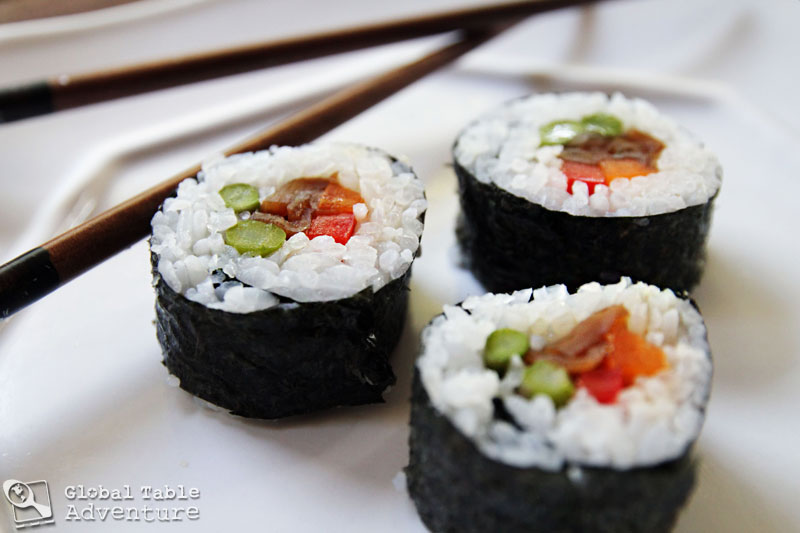
 854 views
854 viewsVegetarian Sushi | Futomaki
globaltableadventure.com
4.0
(1)
Your folders
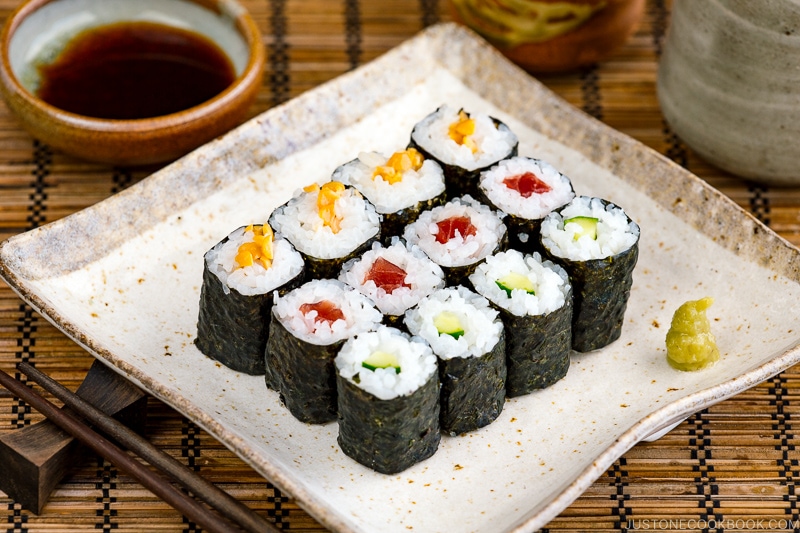
 1046 views
1046 viewsSushi Rolls (Maki Sushi - Hosomaki)
justonecookbook.com
4.7
(7)
Your folders
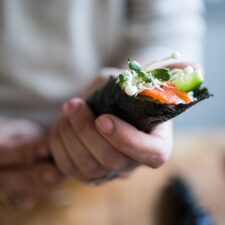
 324 views
324 viewsSushi Hand Rolls
feastingathome.com
5.0
(2)
45 minutes
Your folders
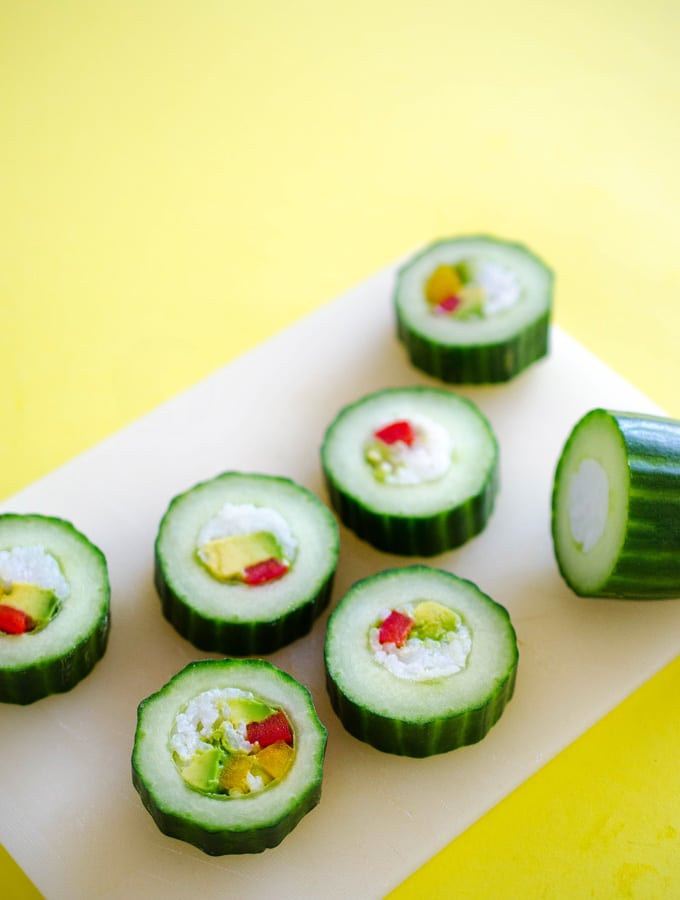
 634 views
634 viewsCucumber Sushi Rolls
liveeatlearn.com
5.0
(9)
Your folders
 76 views
76 viewsCucumber Sushi Rolls
liveeatlearn.com
Your folders

 267 views
267 viewsSimple Sushi Rolls
realmomnutrition.com
4.5
(15)
20 minutes
Your folders

 168 views
168 viewsEllie's Sushi Rolls
stephaniesdish.com
Your folders

 307 views
307 viewsEasy Sushi Rolls
onbetterliving.com
5.0
(15)
15 minutes
Your folders
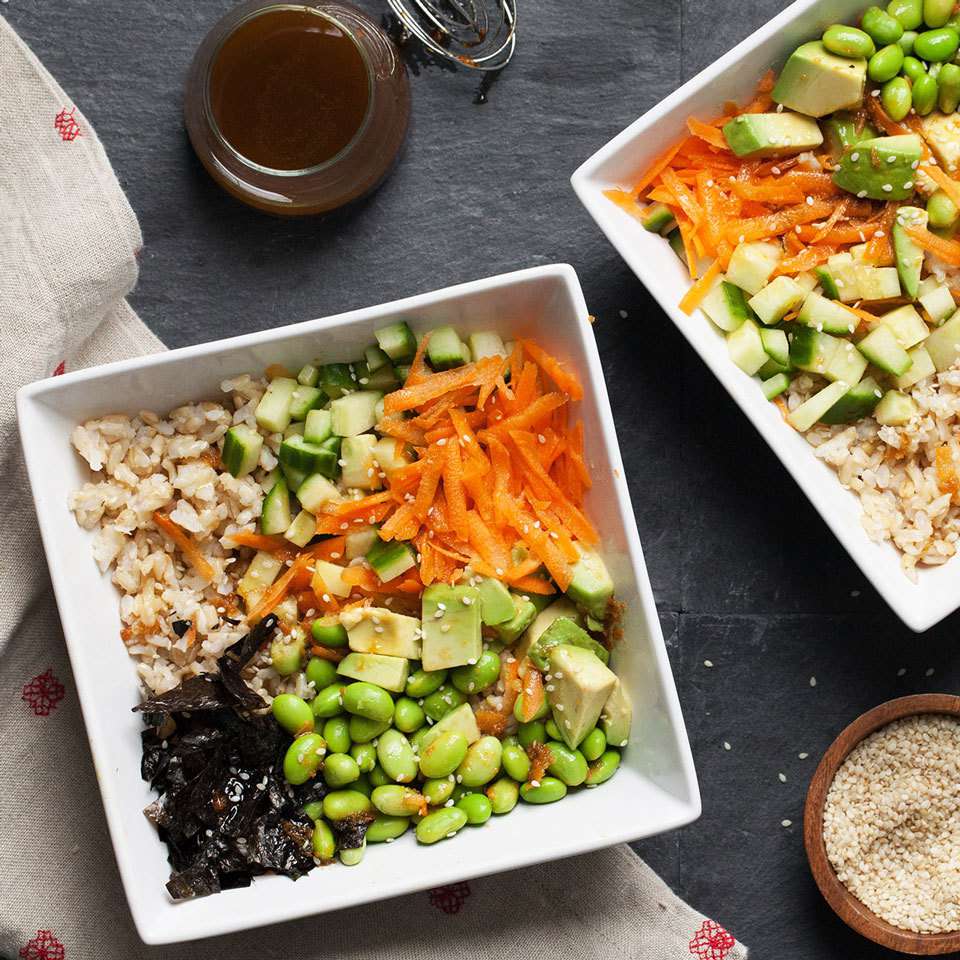
 227 views
227 viewsVegetarian Sushi Grain Bowl
eatingwell.com
5.0
(4)
Your folders

 325 views
325 viewsHosomaki – Thin Sushi Rolls
rotinrice.com
5.0
(1)
25 minutes
Your folders
 204 views
204 viewsEverything Bagel Sushi Rolls
foodnetwork.com
4.2
(6)
15 minutes
Your folders
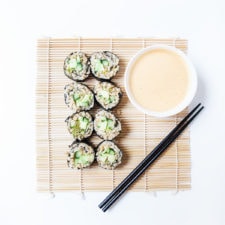
 247 views
247 viewsAvocado Cucumber Sushi Rolls
loveleafco.com
30 minutes
Your folders

 295 views
295 viewsHalloween Banana Sushi Rolls
omgchocolatedesserts.com
Your folders

 217 views
217 viewsQuinoa Avocado Sushi Rolls
californiaavocado.com
Your folders

 224 views
224 viewsSpicy Tomato Sushi Rolls
forksoverknives.com
5.0
(4)
Your folders

 354 views
354 viewsSalmon Maki Sushi Rolls
feastgloriousfeast.com
5.0
(2)
Your folders
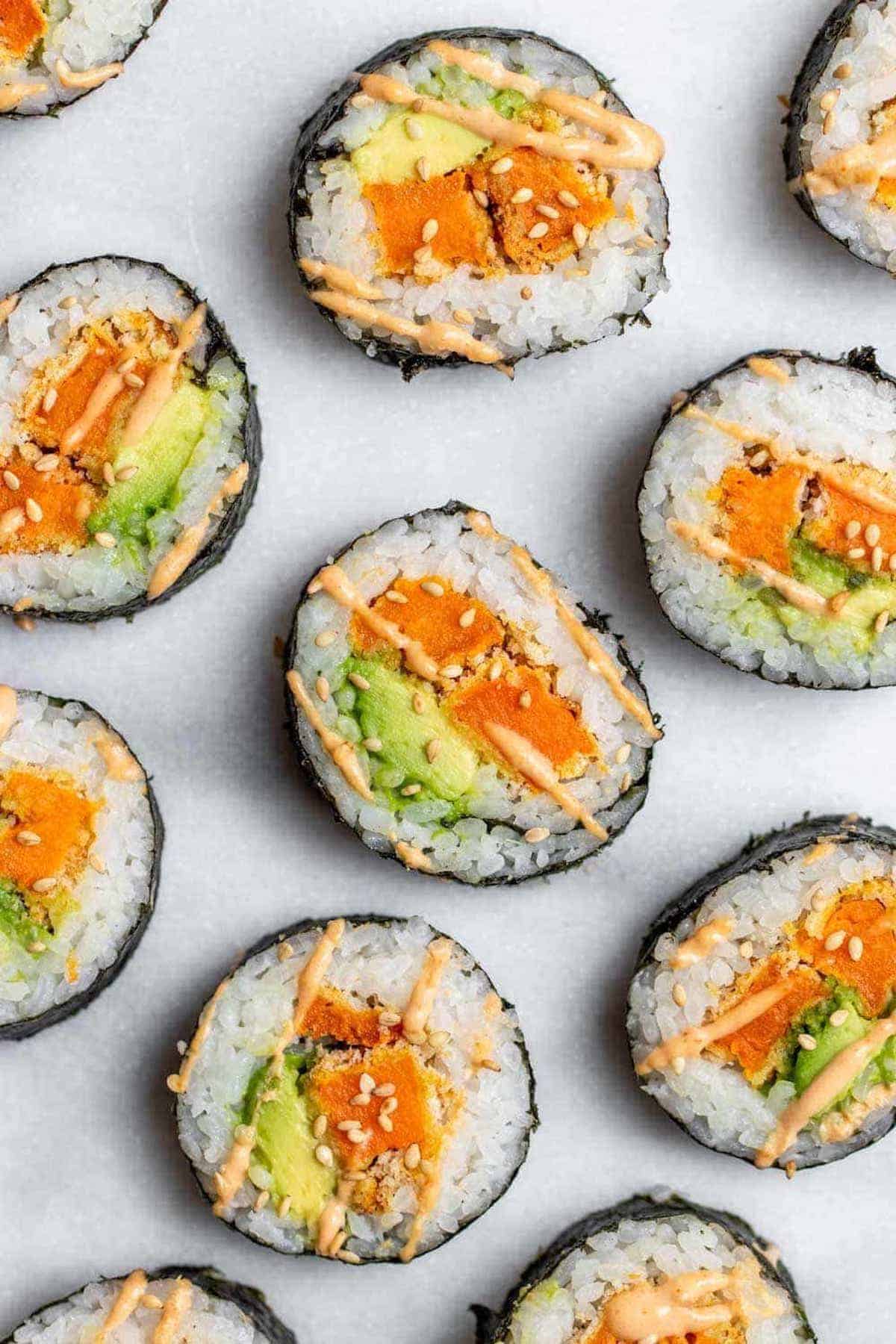
 204 views
204 viewsVegetarian Sweet Potato Sushi Roll
eatwithclarity.com
5.0
(14)
30 minutes
Your folders

 391 views
391 viewsVegetarian spring rolls
taste.com.au
12 minutes